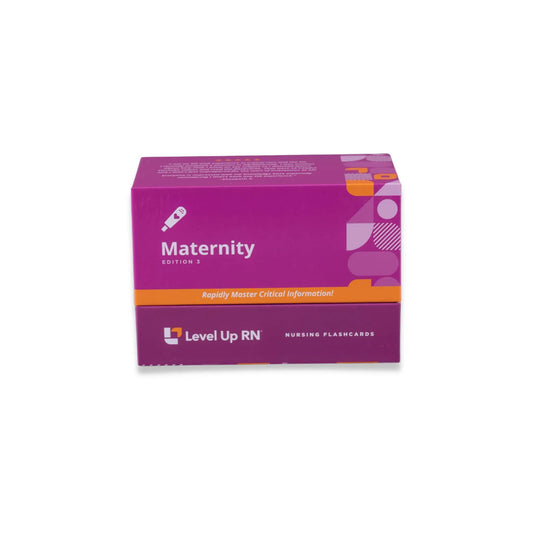Maternity Nursing - Flashcards
This article continues our discussion of fetal assessment, specifically Leopold maneuvers and fetal heart rate monitoring during labor and delivery.
The Maternity Nursing series follows along with our Maternity Nursing Flashcards, which are intended to help RN and PN nursing students study for nursing school exams, including the ATI, HESI, and NCLEX.
Leopold maneuvers
Named for the gynecologist Christian Gerhard Leopold, Leopold maneuvers are a technique used to assess a pregnant patient to determine where and how the baby is lying, without an invasive procedure.
This assessment provides helpful information about fetal attitude, fetal presentation, and fetal position. Leopold maneuvers use external palpation (touch) of the uterus through the abdomen to determine the presenting part, fetal lie, fetal attitude, and point of maximal impulse, also known as PMI, which is the optimal location for listening to the baby’s heartbeat.
Leopold maneuvers are also used to determine the placement of external transducers for fetal monitoring.
Leopold maneuvers — technique
Step 1. With the patient supine, palpate the uterine fundus (the top of the uterus) to distinguish the fetus’s position. Is the baby lying in a cephalic (head down) or breech (feet down) position?
Step 2. Starting at the top, feel along both sides of the uterus to identify the location of the fetal back. The baby’s back will feel smooth, versus the pointier parts of the fetus like the knees and elbows.
Step 3. Palpate above the pubic bone and “pinch” the presenting part in an attempt to distinguish how engaged the fetus is in relation to the pelvis. If part of the fetus is pushed upward, that means it is not fully engaged in the pelvis; if there is difficulty moving the pinched part, that indicates that the fetus is engaged in the maternal pelvis.
Step 4. For a cephalic presentation, face the patient's feet and use your fingers to feel for the baby’s face. Is the fetal head flexed (in a vertex position with chin and limbs tucked, i.e., normal) or extended (face up)?
Fetal heart rate monitoring: external and internal
The fetal heart rate may be monitored or assessed either externally or internally.
External fetal heart rate monitoring
The most common way to monitor the fetal heart rate is using an ultrasound transducer, a non-invasive procedure. A transducer is placed over the point of maximal impulse (PMI), the location on the patient’s abdomen where fetal heart tones can be heard best. A water-soluble gel is applied to the abdomen (and/or on the ultrasound device) to promote sound transmission, and the transducer is held in place with an elastic belt.
Additionally, a pressure-sensitive device known as a tocodynamometer (sometimes shortened to tocometer) is placed at the fundus (top) of the uterus. This is used to measure the strength of the patient’s contractions. Contractions may be viewed on the device as they occur, and the tocometer indicates the strength of each contraction, as well as how long they last.
Used in combination, these two monitors help to assess the fetus’s well-being during labor. For example, how are contractions affecting the baby’s heart rate?
Placement of the heart rate transducer
The heart rate transducer should be placed based on the baby’s position.
If the baby is breech, the transducer is placed on the upper quadrants of the patient’s belly, depending on which way the fetus is facing.
If the baby is cephalic or vertex (head down), then the transducer is placed on the lower quadrant to best assess the fetal heart rate.
Additionally, “listening,” is done through the baby’s back. This is because, if the baby is tucked tightly, it is hard to get a good reading from the front.
Internal fetal heart rate monitoring
Occasionally, it is hard to get an external FHR reading. Perhaps the baby keeps falling off the monitor, forcing frequent adjustments. When the external monitor cannot give an adequate explanation, or if it is disrupting the patient’s rest, or in the event of a high-risk situation or emergency, an internal fetal heart rate monitor may be used.
The internal fetal heart rate monitor is a small electrode that is placed on the presenting part of the fetus and may be used with intrauterine pressure catheter (IUPC). That means it could be placed on a foot or the scapula, for example. Typically, it will be the head. The internal heart rate monitor, when in place, provides a good assessment of what’s going on with the fetus and allows for continuous monitoring.
Risk for infection when using an internal fetal heart rate monitor
The electrode is a tiny needle that will be going inside the patient to get an FHR reading. Because it is penetrating the patient, there will be a concern about the potential for infection.
An internal heart rate monitor should never be used on a patient with HIV/AIDS. This is because, when using an internal heart rate monitor, the membranes must be ruptured when inserting the needle, and that could cause blood mixing, which increases the risk of infection and injury to the patient and/or fetus.
Nursing care when using an internal fetal heart rate monitor
Patients may become concerned about the use of this invasive device. Because of the environment inside of the womb — everything is wet, the baby is covered in fluids and membranes — it is not enough to simply stick an electrode in as, for example, electrodes are put in a patient’s chest for EKG monitoring. When using an internal fetal heart rate monitor, the device must be lightly screwed into the skin, fractionally, to keep it in place. This is what allows for continuous monitoring.


